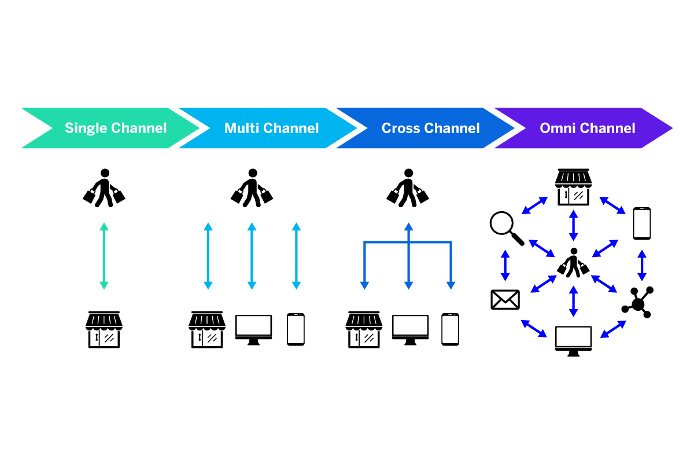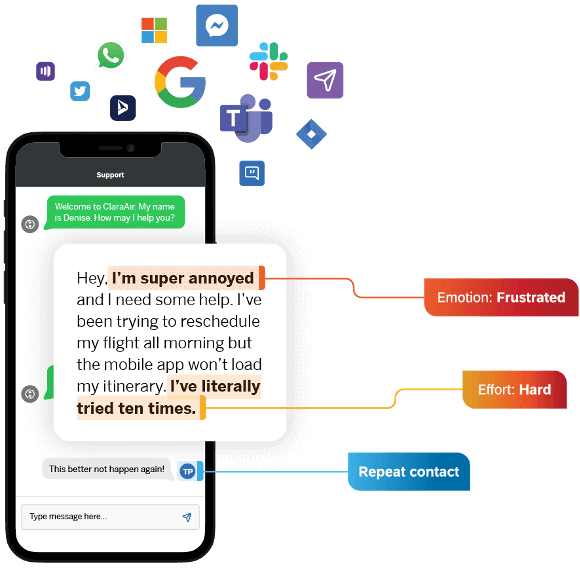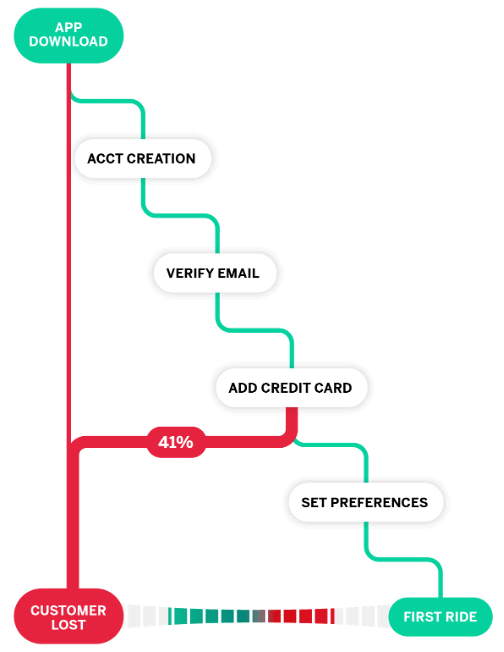What is a digital customer experience strategy?
The term ‘digital customer experience’ refers to the interactions and resulting feelings or opinions that arise from your customers dealing with your business in an online space – in whatever form that may take, and across whichever digital channels they come across.
How to rise to the top in customer experience
In a modern environment that’s a broad spectrum, including everything from your desktop website to connected smart devices, social networks, and AI chatbots. Whatever the channel or touchpoint, if a customer speaks to you, buys from you or even just has a look around a digital-first platform, that’s digital customer experience.
If you need a refresher, we have a huge guide to digital CX here. In this article, however, we’re going to dive in a little deeper and look at the tactical, strategic ways that you can improve that digital customer experience.
Why is digital customer experience so important?
When you’re intimately familiar with every aspect of your business and how each channel operates, it becomes easy to forget that customers rarely see a difference between physical and digital touchpoints these days.

With the world having undergone a complete digital transformation in recent years, the modern customer journey is an omnichannel one, in which in-store and online need to offer a seamless, interchangeable experience. Customers expect brands to offer the same level of support, response, and ease of use across digital channels – which makes nailing the digital customer experience an absolute must.
Those expectations translate to better customer loyalty and – ultimately – an increase in sales. Research shows that brands with the strongest digital customer experience strategies retain 89% of their customers, versus just 33% of those with a poor omnichannel experience.
PWC research, meanwhile, found that 86% of customers are willing to pay more for a great customer experience – while being able to offer a personalised digital customer experience can influence up to 44% of customers to make repeat purchases.
In other words? When you ensure that every part of the digital customer experience is aligned and seamless, customers become much more willing to stick around.
How can you improve the digital customer experience?
Let’s talk about data. Specifically, when you’re trying to improve the overall customer experience, you should be tracking and acting upon what’s called X-data. X-data describes the qualitative experiences customers have, whereas ‘O-data’ describes the operational numbers that affect business figures – quantitative stats like revenue, profit, website traffic, and bounce rate.
In general, your X-data directly influences O-data, so your digital customer experience strategy should be driven by understanding the former. And that’s really a case of understanding what people think and feel after interacting with your business.
Our research shows that there are 3 fundamental ingredients to a good digital customer experience:
Success – did the customer complete their task and achieve their goal?
Effort – was the process smooth and easy?
Emotion – did they come away from the interaction feeling good?
So improving the digital customer experience is all about being able to track and improve those defining factors. We’ll get onto specific strategies in the next section, but first, let’s explore some of the broader ways of working that all modern businesses should adopt to improve digital customer experiences:
1. Think omnichannel
Your customers don’t differentiate between your website, your brick-and-mortar stores, your chatbots, your email marketing, or your social media accounts, so neither should you.
If you really want a digital customer experience that shines, you’ll need to ensure that every team is aligned – and that all your digital touchpoints feel interchangeable. Ideally, you need an omnichannel strategy that enables a workflow where a customer can start a conversation on one platform and continue it seamlessly on another.

2. Act on feedback
Successfully closing the loop on feedback is a two-stage operation. Firstly, you need to be sure that you’re collecting feedback in all the right places. CSAT and NPS surveys are great, but are you also listening to customers on social media, support calls, and third-party review sites, too? Every touchpoint is a valuable source of those success, effort, and emotion indicators, so try and be as thorough and frequent as possible in your feedback collection.
The next step is to actually act on that data. If you know that customers are finding your checkout process to be a chore, for instance, change the way the UX for that part of the journey works.
If your social team is too slow to respond to inquiries, tighten things up. Acting on customer feedback and consumer insight is the only way to close the feedback loop and maintain long-lasting customer relationships.
3. Seek continual improvement
Fixing known issues is a great way to build out a strong digital customer experience today, but what about tomorrow? The customer journey is always evolving, so your digital customer experience strategy should continuously adapt in step.
Improvement in this space is a long game, where iterative improvement should only ever be seen as a step in the right direction, rather than a solved problem.
Digital experience strategy: How to improve
Ok, so how do you put all that into practice? There’s no one silver bullet for improving the digital customer experience – rather, you’ll be able to make things smoother and more streamlined by implementing a range of tactics that come together to form your digital customer experience management strategy.
Here are some tried and tested strategies for managing and improving customer expectations across multiple channels:
Understand how things are right now
It’s impossible to make any meaningful improvements until you have a strong understanding of where your business currently is with its digital customer experience. That means conducting research, proactively gathering customer feedback, running social listening programs, and benchmarking against your competitors.
A customer experience management suite will help you collect all the relevant data, which you can then use to determine the metrics that matter most to you, and what their current baseline is. Those metrics are what you’ll look to make a positive impact on with the rest of your digital customer experience strategy.

Map your customer journeys
We’ve spoken about the importance of thinking with an omnichannel mindset, but how do you ensure that all those channels and platforms provide a uniform customer experience? The first step is to run a customer journey mapping program, which can help you discover (and subsequently tailor things for) a range of different customer journeys.
When we think about things from a customer journey point of view, we’re looking at what the customer wants to achieve, how they might go about it, and what they’re thinking. Customer journey mapping helps you uncover intent and expectations, in other words, which will naturally highlight areas where a specific journey might currently be being underserviced.
Listen smarter with AI
Digital customer journeys that jump from one platform to another can make it difficult to maintain a firm grasp on feedback. Customers might be actively complaining on social media about a specific thing that let them down or leaving reviews on third-party sites. They might be speaking to an agent on the phone, or dealing with a chatbot. If you don’t have a full overview of all of these interactions, it’s impossible to understand how your digital customer experience holds up.
Learn more about listening with AI
This is where AI and machine learning comes in. With a customer experience management tool like Qualtrics Customer XM, all those disparate interactions can be heard, understood, and aggregated together with natural language processing able to determine emotion, effort, and intent.

With that superpower in your arsenal, you’ll be able to understand what customers are really saying to and about you at a huge scale, and in real-time – something that just isn’t possible if your listening tools are siloed and rely on manual processes.
Use personalisation to boost customer experience
If you’re listening to your customers, you can make them feel understood by reacting in a much more personalised way. Digital CX management suites can provide a holistic overview of each customer – including their history, likes, dislikes, pain points, and preferences. You can then use that information to adapt the customer journey to their tastes, or even provide bespoke offers.
Our research shows that 62% of consumers feel that businesses need to care more about them, while 60% would buy more if businesses treated them better – and better personalisation is the key.
Proactively remove friction points
Imagine if you could see, without any uncertainty, exactly where in the customer journey the majority of people abandon their online cart. Or with mobile apps, see where in the signup process people become most frustrated. That’s exactly the level of granularity you need to be tracking with your digital customer experiences. You need to be discovering those experience gaps.
With a tool like Experience iD, you can learn where each experience gap – that’s the gulf between your expectations and the customer’s reality – lies. The key is to be able to take that knowledge, powered by real-time customer data and collated customer feedback, and adjust each digital experience to close those gaps.
Automate time-consuming tasks
As well as being able to listen to your customers across multiple channels and then collate that feedback, AI can also take on some of the more time-consuming jobs faced by customer support agents. In call centres, for instance, post-call work can be a huge time sink. But the right AI-powered tool can do the heavy lifting for agents, automatically scoring the call, determining the outcome, and finding the right next step.
Rather than replacing your human agents, AI in this setting can empower them to do better work by freeing them up to handle more pressing support tickets. That smarter prioritisation, in turn, will improve digital customer experiences.
Track feedback in real-time
Sensing a theme, here? The bulk of the work when it comes to digital customer experience management is all about being able to keep tabs on customer data across digital channels, listen to what customers have to say, highlight digital interactions that are letting them down, and doing so without all that information feeling overwhelming or falling into siloes where it’s of no use.
The solution is to choose the right digital CX software platform – one that can bring all that real-time data together into one place, and use it to provide pragmatic, actionable advice. Digital customer experience strategies are, after all, only as strong as the data that fuels them, so if nothing else, we strongly recommend using technology to help.
Digital customer experience strategy: In a nutshell
The best digital customer experiences are the ones built on a backbone of data. That means having a full, always-on view of all your digital channels, alongside an understanding of how they feed into and support one another.

With so many platforms and channels now incorporated into the overall digital customer experience journey, any solution that relies on manpower alone isn’t going to cut it. To truly track customer feedback, uncover pain points, and make the most of every available piece of X-data, you’ll need a customer experience management suite that can listen and analyse in real-time, automatically.
Crucially, the most powerful tools in this area are ones that can take all that structured and unstructured data and turn it into actionable insights that you can use to improve every part of the customer journey. Do that, and you’ll unlock a whole new level of customer satisfaction.
Discover how to turn customers into fans